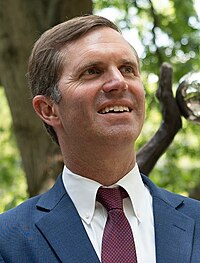| Governor of the Commonwealth of Kentucky | |
|---|---|
 | |
 | |
since December 10, 2019 | |
| Government of Kentucky | |
| Style | Governor (informal) The Honorable (formal) His Excellency (diplomatic) |
| Type | Head of state Head of government |
| Member of | Kentucky Executive Branch Kentucky Cabinet |
| Residence | Kentucky Governor's Mansion |
| Appointer | Popular vote Line of succession |
| Term length | Four years, renewable once consecutively |
| Constituting instrument | Constitution of Kentucky |
| Inaugural holder | Isaac Shelby |
| Formation | June 4, 1792 |
| Deputy | Lieutenant Governor of Kentucky |
| Salary | $164,355 (2023)[1] |
| Website | governor |
The governor of the Commonwealth of Kentucky is the head of government in Kentucky. Sixty-two men and one woman have served as governor of Kentucky. The governor's term is four years in length; since 1992, incumbents have been able to seek re-election once before becoming ineligible for four years. Throughout the state's history, four men have served two non-consecutive terms as governor, and four others have served two consecutive terms, the most recent being current governor Andy Beshear, who was re-elected to a second term on November 7, 2023. Kentucky is one of only five U.S. states that hold gubernatorial elections in odd-numbered years.
The governor's powers are enumerated in the state constitution. There have been four constitutions of Kentucky—adopted in 1792, 1799, 1850, and 1891, respectively—and each has enlarged the governor's authority. Among the powers assigned to the governor in the constitution are the ability to grant pardons, veto legislation, and call the legislature into session. The governor serves as commander-in-chief of the state's military forces and is empowered to enforce all laws of the state. The officeholder is given broad statutory authority to make appointments to the various cabinets and departments of the executive branch, limited somewhat by the adoption of a merit system for state employees in 1960. Because Kentucky's governor controls so many appointments to commissions, the office has been historically considered one of the most powerful state executive positions in the United States. Additionally, the governor's influence has been augmented by wide discretion in awarding state contracts and significant influence over the legislature, although the latter has been waning since the mid-1970s.
The history of the office of Governor is largely one of long periods of domination by a single party, though different parties were predominant in different eras. Federalists were rare among Kentuckians during the period of the First Party System, and Democratic Republicans won every gubernatorial election in the state until 1828. The Second Party System began when the Democratic-Republicans split into Jacksonian Democrats (the predecessor of the modern Democratic Party) and National Republicans (later to become Whigs). Beginning with the election of Thomas Metcalfe in 1828, the Whigs dominated the governorship until 1851, with John Breathitt being the only Democrat elected during that period.
With the collapse of the Whig Party in the 1850s, Democrats took control of the governorship for the duration of the Third Party System, with Charles S. Morehead of the Know Nothing Party being the only exception. The election of Republican William O'Connell Bradley in 1895 began the only period of true two-party competition for the governorship; from Bradley's election through 1931, five Republicans and six Democrats held the office of governor of Kentucky. Since 1931, only four Republicans have served as governor of Kentucky, and no Republican governor has ever been re-elected; the most recent past governor, Matt Bevin, lost re-election.
- ^ "Transparency.ky.gov - Salary Search". May 25, 2023. Retrieved May 25, 2023.
